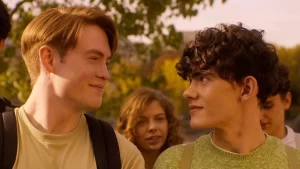No products in the cart.
Heartstopper Season 2: Unraveling the Magic
“Heartstopper Season 2” isn’t merely a sequel to a romance. It’s a profound journey into identity, acceptance, and the trials of maturing as a queer individual in a world still grappling with understanding. Building upon its predecessor, this season immerses us deeper into Charlie and Nick’s world, while weaving in fresh tales that echo with many in the LGBTQ+ sphere.
This season is a storytelling marvel, encapsulating young romance, identity intricacies, and the societal barriers that often question it. Infused with humor, warmth, and profoundness, it pledges a voyage of self-realization, affection, and the quest for joy.

Critics’ Highlights on Heartstopper Season 2
“Heartstopper Season 2” has garnered immense acclaim, with both critics and viewers lauding its authentic depiction of youthful romance, acceptance, and the hurdles queer youngsters encounter. Key insights include:
Redefining Queer Stories: This season shatters the stereotypical tragic queer plots, offering a rejuvenated view on LGBTQ+ portrayal in mainstream content.
Depth & Authenticity: While the debut season was adored for its dreamy allure, this season brings in more depth, hurdles, and character evolution, making it more poignant and influential.
Character Evolution: The series highlights the metamorphosis of its protagonists, especially Nick and Charlie, as they maneuver through love, identity, and societal norms.
Cultural Resonance: “Heartstopper Season 2” has been extolled for its affirmative influence on the LGBTQ+ realm, serving as a beacon of hope and representation in a frequently deficient world.
Artistic Mastery: The series’ artistry, encompassing its animations and melodies, has been celebrated for amplifying the overall spectator experience.

Breaking Queer Narrative Stereotypes
For eons, mainstream media’s queer tales were marred with sorrow, often culminating in despair or demise. “Heartstopper” shatters this archetype, offering a refreshing, optimistic view on queer romance and acceptance. This season especially delves into the tribulations queer youth face, providing a portrayal that resonates with many.
The series exalts the joys of young love while addressing the tangible challenges the LGBTQ+ community faces. From societal norms to personal battles, “Heartstopper” encapsulates the essence of maturing queer in the contemporary era.
Heartstopper Season 1’s Dreamy Landscape
The inaugural season of “Heartstopper” was an ode to young love, presenting a dreamy realm where love triumphs. Laden with warmth, wit, and a sprinkle of idealism, it swiftly became a crowd favorite. This season was a storytelling marvel, winning hearts with its genuine depiction of love, acceptance, and youthful exuberance.
Yet, with Heartstopper Season 2, the tale adopts a more pragmatic approach, introducing hurdles, depth, and character growth absent in its forerunner. This season pledges a journey of self-realization, affection, and the quest for joy, making it essential viewing.

Heartstopper Season 2’s Grounded Realism
“Heartstopper Season 2” veers away from its predecessor’s dreamy realm. While the first season was a comforting embrace of love and acceptance, this installment presents a more rooted and genuine depiction of the challenges queer youth face. The narrative boldly addresses identity intricacies, societal norms, and personal evolution.
From the outset, spectators are ushered into a realm where the camera’s comforting radiance is supplanted with tension and strife undertones. Characters, especially Nick, wrestle with inner conflicts, torn between their passions and societal views. This season delves into relationship nuances, coming-out challenges, and the tangible struggles the LGBTQ+ community faces.
Character Arcs and Hurdles
“Heartstopper” thrives on its multifaceted characters, each with distinct hurdles and growth trajectories. Nick’s journey this season is especially moving as he grapples with his identity and the challenges of coming out as bisexual. His internal strife, torn between his love for Charlie and societal norms, resonates with many.
Elle’s character also undergoes significant evolution. As she explores her identity and finds comfort in a new friend circle, her journey epitomizes the hurdles and joys of self-discovery. This season masterfully captures the peaks and troughs of maturing, the joys of self-realization, and the inevitable challenges accompanying it.

The Power of Genuine Representation
“Heartstopper” has been extolled for its genuine LGBTQ+ portrayal. In a realm where queer tales are often marred with sorrow, this series offers a refreshing, optimistic perspective. This season, in particular, has been lauded for its genuine depiction of the challenges queer youth face, making it a beacon of hope and representation.
The series isn’t merely a romance tale; it narrates the stories of countless individuals who see themselves in Charlie, Nick, and the myriad of characters that populate its universe. It’s a celebration of love, acceptance, and the potency of representation.
The Show’s Artistic Brilliance
Beyond its gripping tale, “Heartstopper Season 2” is a visual and auditory delight. The series’ artistic facets, from its distinct animations to its poignant soundtrack, elevate the overall viewing experience. This legacy continues in Season 2, with its artistic elements seamlessly complementing its narrative.
The animations, especially, are noteworthy, capturing the graphic novels’ essence and infusing whimsy into the tale. The soundtrack, with its indie track mix and poignant scores, sets the ambiance, making each episode a sensory delight.

Supporting Characters’ Pivotal Roles
While Charlie and Nick are “Heartstopper’s” core, the secondary characters enrich the narrative. Each character, from the supportive educators to the antagonists, offers a unique tale layer, adding depth and intricacy.
Tara and Darcy, for instance, offer a fresh view on the challenges queer women face, underscoring their experiences compared to their male counterparts. Their self-discovery, acceptance, and love journey epitomize the series’ diverse representation commitment.
Conversely, characters like Ben and Aled illuminate the darker facets of maturing queer, from bullying to internalized homophobia. Their tales serve as a stark reminder of the challenges many LGBTQ+ individuals face, even in seemingly progressive societies.
Global Resonance and Acclaim
“Heartstopper” has transcended boundaries, resonating globally. Its genuine portrayal of love, acceptance, and the challenges the LGBTQ+ community faces has resonated with spectators, leading to widespread acclaim.
Critics have extolled the series for its nuanced storytelling, character evolution, and representation commitment. From its poignant soundtrack to its unique animations, every “Heartstopper” facet has been meticulously crafted, making it a standout in LGBTQ+ storytelling.
Comparing with the Graphic Novels
Adaptations often grapple with staying true to the original while forging a distinct identity. “Heartstopper” achieves this equilibrium, capturing Alice Oseman’s graphic novels’ essence while weaving in fresh tales and character arcs.
While the series retains the novels’ warmth, wit, and depth, it delves deeper into its characters’ challenges, offering a more rooted and genuine portrayal. This idealism and realism blend sets “Heartstopper” apart, making it essential viewing for novel aficionados and novices alike.
Anticipations for the Series’ Future
Given the initial two seasons’ success and the series’ global resonance, “Heartstopper’s” future seems bright. While no official announcement exists for a third season, the narrative offers ample exploration avenues, from the protagonists’ tales to the secondary characters’ stories.
With its representation commitment, genuine storytelling, and artistic brilliance, “Heartstopper” is set to etch a lasting entertainment world legacy.
Behind the Magic: Crafting Heartstopper
The enchantment of the “Heartstopper Season 2” isn’t limited to its tale; it’s evident in its creation. The series, celebrated for its unique animations and poignant melodies, is the collaborative effort of a gifted creator, actor, and artist team.
The animation style choice, inspired by Alice Oseman’s graphic novels, infuses whimsy into the tale, capturing young love’s essence. The soundtrack, with its indie track mix and poignant scores, sets each episode’s mood, making it a sensory delight.
The series’ casting is another highlight. The actors, with their genuine portrayals, infuse life into the characters, making them relatable and lovable. The lead actors’ chemistry, especially, has been extolled for its genuineness, capturing Charlie and Nick’s bond essence.

Heartstopper’s Cultural Impact
In today’s era, where representation is paramount, “Heartstopper” stands as a hope beacon. Its genuine LGBTQ+ portrayal, devoid of clichés and stereotypes, makes it contemporary media’s standout.
The series, focusing on love, acceptance, and queer youth challenges, resonates globally. It’s not merely a romance tale; it’s an identity, acceptance, and representation power celebration.
“Heartstopper” has ignited representation, acceptance, and diverse storytelling importance discussions. Its impact transcends entertainment, making it a cultural sensation.
LGBTQ+ Media Representation’s Future
“Heartstopper” epitomizes media representation’s evolving landscape. The days of clichéd, tragic queer tales are gone. Today, series like “Heartstopper” are heralding genuine, positive representation.
The series’ success underscores storytelling’s power. It’s a clarion call for creators, urging them to prioritize diverse representation and narrate tales that resonate universally.
Looking ahead, one thing is evident: genuine representation demand is surging. Series like “Heartstopper” are trailblazing, setting future tales’ benchmark.
Heartstopper’s Enduring Legacy
“Heartstopper” isn’t merely another series; it’s a cultural sensation. Its genuine love, acceptance, and LGBTQ+ community challenges portrayal has made it contemporary media’s hope and representation beacon. Reflecting on Charlie, Nick, and its universe’s myriad characters, one thing is evident: “Heartstopper” celebrates all love forms.
Heartstopper Season 2, especially, underscores the series’ nuanced storytelling commitment. It immerses us deeper into its characters’ lives, offering a more rooted and genuine challenges and triumphs portrayal. From its poignant soundtrack to its unique animations, every “Heartstopper” facet has been meticulously crafted, making it LGBTQ+ storytelling’s standout.
As we await subsequent episodes, one thing is certain: “Heartstopper” has etched an indelible global mark. Its legacy is love, acceptance, and representation power, making it essential viewing for all.
Concluding Remarks
“Heartstopper” celebrates all love forms. Its genuine LGBTQ+ portrayal, combined with its artistic brilliance, makes it essential viewing. As we await subsequent episodes, one thing is certain: “Heartstopper” has etched an indelible entertainment world mark.
Read Further:
- USA Today Review
- GQ Magazine Insights
- Decider’s Premiere Date Info
- Collider’s First Look
- Vanity Fair’s Take
Continue Reading:
FAQs
1. How does “Heartstopper” compare to other LGBTQ+ series?
“Heartstopper” distinguishes itself with its genuine representation, nuanced storytelling, and diverse representation commitment. It offers a rejuvenated view on queer love and acceptance, distinguishing it from its genre peers.
2. What can spectators anticipate from subsequent episodes?
While no official third season announcement exists, given the series’ global resonance and reception, there’s a strong likelihood of subsequent episodes that immerse deeper into its characters’ lives.
3. How has the series impacted the LGBTQ+ community?
“Heartstopper” has been extolled for its LGBTQ+ community positive impact, serving as a hope and representation beacon in a frequently deficient world.
4. Are there any spin-offs or related series in the pipeline?
Currently, no official spin-offs or related series announcement exists. However, given the series’ success, it’s a future possibility.
5. Where was “Heartstopper Season 2” filmed?
The series was primarily shot in the UK, staying true to its British origins and the graphic novels’ setting.
6. Who are “Heartstopper’s” creators and key contributors?
“Heartstopper” is based on Alice Oseman’s graphic novels. A gifted creator, actor, and artist team has brought the series to life.
7. Is “Heartstopper” suitable for younger spectators?
While “Heartstopper” celebrates young love, it also delves into mature themes. It’s recommended for older teens and adults.
8. How can aficionados support the series and its message?
Afidicionados can support “Heartstopper” by streaming it on Netflix, purchasing the graphic novels, and promoting its love and acceptance message on social platforms.







1 comment